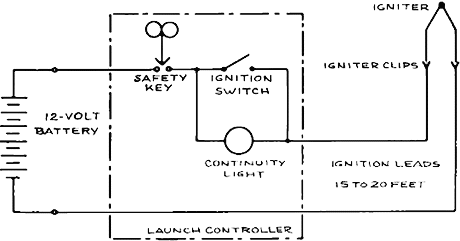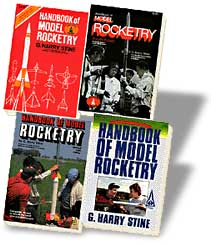The Handbook of Model Rocketry, by G. Harry Stine is the official handbook of the National Association of Rocketry. If you don’t have this book, you should definately buy and read it. Aside from being a thorough introduction to the hobby, it makes entertaining reading. The extract below was taken from the Sixth Edition.
Copyright © 1994 G. Harry Stine. Published by John Wiley & Sons, Inc.

A wiring diagram for a typical electric launch controller is shown in [above figure]. This is the basic circuit diagram for nearly all commercial electric launch controllers, too. You can see how the safety key opens the electrical circuit.
Notice the continuity light. This is wired across the ignition switch. It was invented in 1961 by Vernon D. Estes. It is a small light bulb that lights up when you insert the safety key–if you’ve hooked up the igniter and everything is ready. The continuity light allows a small amount of current to pass through the circuit, but not enough to get the igniter warm. It is a “limiting electrical resistance.” When the ignition switch is pushed and closed, the light bulb is bypassed by the low-resistance circuit of the ignition switch, allowing the full battery current to flow through to the igniter.
For a 6-volt ignition system, a Type 47 bayonet-base lamp bulb (Radio Shack part No. 272-1110) should be used; this will allow only 0.05 ampere to pass through the circuit. For 12-volt systems, use a Type 53 bulb (Radio Shack part No. 272-1117) which will allow 0.12 ampere through the circuit. The proper bayonet-base socket that fits both lamp bulbs is also available (Radio Shack Part No. 272-325).
Instead of a continuity light, some people use a piezoelectric buzzer that sounds off audibly. Radio Shack has a wide variety of these. Make sure that the unit draws less than 150 milliamperes (0.15 ampere) when it’s working. The specifications on the package will tell you about this.
The current passed by continuity lights and buzzers is enough to activate some of the igniter types used in advanced rocketry. Such igniters use flashbulbs or sensitive “electric match” units. When you get to that point in model rocketry, test your system ahead of time to see if these advanced sensitive ignition elements fire when you arm the system with the safety key. It doesn’t take very much current to fire a flashbulb. Advanced ignition elements are not covered here because the technology is changing rapidly and may be different by the time you get to the point where you’re using such things. For now, just be aware of these facts.
Except for electrical ignition systems used exclusively for the Estes Solar Igniter or Quest Tiger Tail, the wire used between the launch controller and the launch pad should be #18AWG stranded copper. Don’t use doorbell wire; that’s too small and has too much resistance. Solid wire will break easily after being flexed a few times. Don’t use “loudspeaker wire” which is usually #22AWG insulated stranded pair. What you want is commonly available #18AWG-2 insulated stranded rubber–or plastic–covered lamp cord, commonly called “zip cord.” Or you can cut up a long extension cord made of the same double wire. Rubber-covered wire is preferred because rubber insulation flexes easily over a wide temperature range; plastic-covered zip cord gets stiff in the cold of wintertime flying.
The use of robust wiring should carry through the entire system. Heavy wiring and good connections reduce the electrical resistance of the system. Resistance causes the wires and connections to get hot. You don’t want this. You want the igniter to get hot, not the firing system!
The NAR Model Rocket Safety Code requires that you be at least 15 feet from the launch pad if you’re flying motors up to 30 newton-seconds (midrange Type E) and 30 feet when launching anything with more power than that. It is suggested that you put a minimum of 35 feet of firing leads on your controller. This will allow you to fly everything up to and including a Type G motor without changing firing systems. Why the extra 5 feet? Over time, you’ll be replacing the firing clips on the launcher end of the wires. The easiest way to do this is to cut the clips off, strip the wires, and install new clips. Over a period of time, the firing leads therefore grow shorter and shorter. So give yourself some extra to start with. The old advice of electricians should be heeded here: It’s easy to cut off wire that’s too long, but it’s difficult to stretch wire that’s too short.
You’ll need something to hook the ignition leads to the igniter ends. Don’t use big, heavy “alligator” clips. You can use ordinary, garden-variety metal paper clips; they work fine, but you must solder the firing leads to them. (They don’t work very well with Quest Tiger Tail igniters.) Commercial electrical firing systems come with little spring clips called “micro clips.” Many companies make these. Ask for Mueller No. 34 Microgator clips or Radio Shack part No. 270-373 All-Purpose Micro Clips. Both of these have smooth jaws rather than the serrated or saw-toothed jaws of other clips. The smooth jaws won’t pierce the copper foil of Quest Tiger Tail or AeroTech Copperhead igniters and cause them to short out. These micro clips are cheap, so buy some spares because you’ll have to replace them after a few hundred flights or so. They will become cruddy with exhaust residue, bent, and otherwise difficult to use. You can easily replace one in the field by cutting off the old one, stripping back the wire insulation about 1/8 inch, and attaching a new clip by squeezing its tabs down on the bare wire with a pair of pliers. (You can solder it later when you get back to your shop.)
Before each launch session, test your electrical firing system to make sure it’s working properly. Having a premature launch or a misfire is the hard way to test it. Use one of the spare igniters in your range box. (You mean you didn’t bring any extra igniters along just in case?) Hook the clips to it without putting the igniter in a model rocket motor. When the safety key isn’t installed in the controller, you should be able to push the launch switch without the igniter activating. Then put in the safety key. The continuity light should come on (or the continuity buzzer should sound). If it doesn’t, something is wrong. Usually, it means dead batteries. Or the safety key isn’t completing the circuit. If the light/buzzer comes on, then push the ignition switch. The igniter should fire when you do this. If the igniter doesn’t activate, go into the troubleshooting mode.
The continuity light (buzzer) will not tell you that you don’t have a short circuit between the clips or between the clips and any metal launch pad parts such as the jet deflector. You must check this visually when you’re hooking up the igniter. The continuity light will tell you by failing to light up that you have dirty clips, a dead battery, or more serious problems inside the launch controller.
Here’s a quick tip that makes using Quest Tiger Tail igniters faster and easier to use. Use a piece of tape–electrical or paper–to insulate one jaw of each micro clip. Or you can slip a short piece of shrinkable plastic tubing over one of the jaws instead of using tape. When attaching these micro clips to the foil of the Tiger Tail, place the insulated jaw of one clip on one side of the foil and the insulated jaw of the other clip on the other side of the foil. You don’t have to use the Tiger Tail tape on the foil lead if you do this. This also works with the AeroTech Copperhead igniters, eliminating the need to use the special clip.
If you make your own electrical firing system, build it to last. Solder all connections if possible. Don’t just wrap or twist the wires together. Remember: The system will have to pass enough electric current to operate a toaster or a 500-watt electric light bulb. Build it so those little bitty electrons can get from the battery to the igniter with as little resistance as possible once you push the firing switch.
Harry Stine died in 1997. The NAR web site contains a eulogy for him.
G. Harry Stine 1928-1997
Harry’s most enduring legacy to the hobby was the Handbook of Model Rocketry. Serving as both the official handbook of the NAR and the “bible” of the hobby, the Handbook, through six editions and numerous reprintings, brought sport rocketry to hundreds of thousands of modelers, not only in the US, but all around the globe.

Submitted by: John Coker